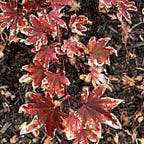Mathematics of a Flower
Fibonacci Patterns & Flowers in the Neighborhood
A flower so tiny, fragile, transient, and still so determined !! Its inception, the budding phase, it's delicate growth, and transformation into a fully bloomed flower filled with radiance and energy is totally brilliant. Have you ever pondered about the arrangement of the petals? So elastic and resilient to all conditions?
They could be arranged in multilayers and apparently, the number of petals in any layer conforms to one of these numbers 1, 2, 3, 5, 8, 13, 21, 34, 55.. .. Unbelievable it seems to be.. The dots on the strawberry, the cones and the shells, and all things around conform to this sequence and ratio… The creator’s formula..
God is a great mathematician and he made the world with such accuracy…
I took some time to observe the fall season flowers in my neighborhood..
The pink bunch hugging in 4s and 3s [pic 2]
The indigo buds marching up in 3s [pic 3]
The tiny violet pentagon cups pairing in 3s [pic 4]
The red rose lazily waking up to bloom 8 5 5 [pic 6]
The tiny shades of orange red snowflakes spiraling in 5s [pic 7]
The tiny pearl like 5 walled baskets glittering in the sun [pic 4]
I cut open a cauliflower and wow .. that was also like 5 5 5 5..
5 seems to be versatile structure in kingdom of flowers.
It is interesting to note that Passion flower has 3, 5, 55 and 8 all in one flower. In the Indian context, the blue passion flower is called Krishna Kamal. The 3 is compared to brahma-vishnu-maheshwara, 5 with panch pandavas and 55 with 100 kauravas.. . I have distant memories of crossing the creeper each time we had to jump across the wall to take a shortcut to school during KV DRDO times. Wish I could time travel and count.
When my mind drifts..my gut tells me at times, a lot of pattern-based mathematics must be inspired from flowers. The Inplace multi-digit multiplication aka rainbow technique, the transpose reverse operations involved in balancing and solving linear equations, addition of fractions and transpose moves in balancing the formation of odd numbered magic squares.. Just like how vortices of energy flows up in our spine as Chakra or radial wheels, there is so much in these tiny flowers that we can admire and imagine..
A deeper look into these numbers.. 1, 2, 3, 5, 8, 13, 21, 34, 55..Each number can be put as sum of the previous 2 numbers..For a flower, maybe it means accommodating the packing structure of neighboring layers. In early programming days, we learned them as Fibonacci Numbers.. Actually, these numbers were first documented by Jain Poet Mathematician by the name Hemachandra and later by Fibonacci. A simple way of looking into this problem.
Hemachandra had a unique problem. If he were to use 2 types of syllables… Long and Short or think in Tabla terms Dhaaaa[D] and Dhin[d].. Think Dhaaaa takes 2 time units and Dhin takes 1 time unit.. How many combinations of Dhaaaa and Dhin would be possible for any time period t..
t=1 d
t=2 dd or D
t=3 dD ddd, Dd
t=4 ddD, DD dDd, dddd, Ddd
t=5 dDD, dddD, DdD ddDd, DDd, dDdd, ddddd, Dddd
Think of 2 Buckets B1 and B2.. One having just previous previous codes and other having previous codes. Suffixing D or dd to B1 and d to B2 gives us the desired result. Sequence for t=4 can be derived from t=2 and t=3.
It is amazing to see the use of these numbers in poetry, music, nature. Apparently it is also getting used in fashion industry and knitting..
